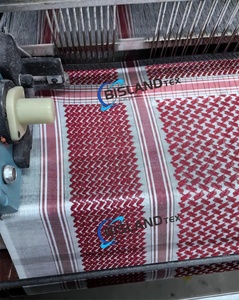(5528 products available)
























































































































































































A loom is a machine or tool used to weave threads and yarn into fabric or cloth. There are many kinds of looms based on their construction and working principles. Here are some popular types:
Some general specs and maintenance tips of rapier weaving loom are as follows:
All weaving machines require regular maintenance to ensure they are working effectively. Here are some general maintenance tips for rapier weaving machines:
The loom rapier is the best machine to weave heavy and wide fabrics. This includes upholstery fabrics, technical textiles, denim, cotton duck, broadcloth, tarp material, mock-linen, and other heavy and thick textile materials. The rapier system has no weft tension during insertion. This allows it to be used for weaving such thick and heavy textile materials.
It is also the preferred device to use for weaving fabrics with a pile or hairy construction, such as terry cloth and velvet. Because of the low weft tension, the device can insert wefts with loops into the warp shed. Furthermore, its delicate and smooth picking action can prevent loop damage.
This type of loom can weave multi-layered and complex fabrics, such as sandwich composites or layered textiles. The rapier's ability to handle a wide range of fabric structures and its precise weft insertion make it suitable for weaving intricate and stratified fabrics that require multiple layers to be incorporated.
The loom rapier is also an excellent device to use for weaving fabrics with heavy or bulky yarns, such as rope and ottoman. The rapier's gentle handling and adaptability enable it to accommodate the increased size and texture of yarns, resulting in weaving fabrics with substantial, weighty, and textured characteristics.
When buying loom rapiers for sale, w buyers should consider the following tips.
Fabric Type and Weight:
Determine the types of fabric one plans to work with, including their texture, density, and lightweight. Different rapier looms are designed to handle specific fabric types and weights, so it's crucial to select a machine that can efficiently and effectively weave the intended materials.
Production Speed:
Consider the desired production speed for weaving operations. Weaving speed can significantly impact output and efficiency. Select a rapier loom that aligns with the required production speed. Additionally, take into account the speed at which the fabrics will be woven without compromising quality.
Machine Size:
Consider the loom's machine size to ensure it fits perfectly within the work environment. A suitable rapier loom machine size will allow easy operation and management of other equipment in the workshop. The machine's size may also impact production efficiency and capacity.
User-Friendly Controls:
The looms may have different types of controls and operating systems. Consider the machine's controls and ensure they are user-friendly and intuitive. User-friendly controls enable easy operation and minimize the training and learning required for the staff.
Maintenance and Support:
When buying rapier looms for sale, it is essential to consider the maintenance and support required for the selected rapiers. Choose looms that are easy to maintain, as this helps to ensure long-term operational efficiency and reduces downtime. Additionally, consider the availability of technical support and spare parts for the rapiers. Consider looms with good support networks to ensure quick assistance when needed.
Q1: What are the latest trends in loom rapier technology and design?
A1: The industry is witnessing several trends. Looms are being integrated with digital technologies for better automation and efficiency. Manufacturers are also seeking looms that consume less energy and have a lower environmental impact. There is also a growing aftermarket for upgrades as looms are increasingly fitted with modern features to extend their lifespan.
Q2: What is the market size of loom machine manufacturing?
A2: The global weaving machine market size was valued at \\$1.6 billion in 2022 and is projected to reach \\$2 billion by 2032, growing at a CAGR of 1.8% during the forecast period.
Q3: What factors are driving demand for loom machines?
A3: The primary factors are the shift toward automated production in the textile industry, rising labor costs and the global demand for textiles, especially in the home and fashion markets.
Q4: What are the leading manufacturers of loom machines?
A4: There are several leading manufacturers of loom machines worldwide. They include Picanol, Smit, Dornier, Tsudakoma, and Itema. These companies manufacture a wide range of loom machines, primarily focusing on rapier and air-jet technology.